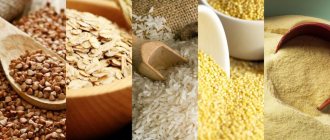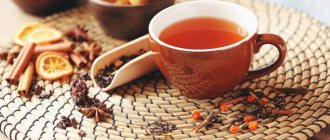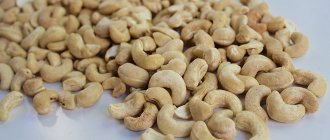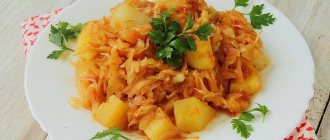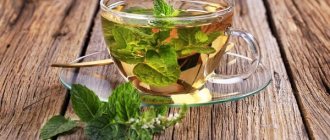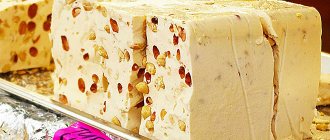During breastfeeding, a woman's diet is very limited so as not to harm the baby. Most sweets are prohibited. A delicacy that is relatively safe for a nursing mother - home-made jam - comes to the rescue.
Photo: Depositphotos.com. Author: victoreus.
This is an excellent source of carbohydrates that energizes a woman and increases her vitality. Jam stimulates the production of serotonin (the hormone of happiness), relieves nervous tension and symptoms of fatigue, strengthens sleep and reduces the intensity of pain, has a beneficial effect on lactation, increasing milk flow.
Good to know. The desire to treat yourself to something sweet is not such a whim. It occurs when there is a lack of glucose or minerals (such as magnesium, chromium or phosphorus).
How to introduce it into the diet?
- Meet deadlines. Rushing can cause an allergic reaction or digestive problems in your baby.
- Start with the safest varieties, because brightly colored fruits often cause increased gas formation and colic in babies.
- Don't eat on an empty stomach. The first time, no more than 1 tsp is allowed. per day. Then the dosage can be gradually increased to the maximum allowable 4-5 tsp.
- Before use, heat slightly in a water bath so that the crystallized sugar becomes liquid.
- Add new types little by little to those already tried.
- Try to enjoy jam in the first half of the day so that you have the opportunity to watch your baby.
Possible negative reactions in the baby:
- allergic rash;
- swelling and redness of the skin or mucous membranes;
- peeling;
- colic in the tummy;
- problems with stool.
If problems are detected, jam should be immediately excluded from the menu and seek advice from a pediatrician.
Introduction timing table
| Jam | Month | ||||
| 1 | 2 | 3 | 4 | 6 | |
| Apple | + | + | + | + | + |
| Pear | + | + | + | + | + |
| From gooseberries | + | + | + | + | + |
| Peach | + | + | + | + | |
| Cherry | + | + | + | + | |
| Strawberry | + | + | + | + | |
| Sea buckthorn | + | + | + | + | |
| Strawberry | + | + | + | + | |
| Currant | + | + | + | ||
| Plum | + | + | + | ||
| Blueberry | + | + | + | ||
| Blackberry | + | + | + | ||
| Apricot | + | + | + | ||
| Lemon | + | + | |||
| Raspberry | + | ||||
| Rosehip | + | ||||
Can a nursing mother eat raspberry jam?
Breastfeeding is not accompanied by strict restrictions. It is important to eat foods correctly and introduce them into your diet. Women often ask, is it possible to use jam while breastfeeding? Raspberry jam is allowed. It is very good for health, but it is an allergen, which forces you to adhere to special rules. When used, the product will not harm your baby.
In the first month after birth
The first month after the birth of a baby is a special time. During this period, the child’s gastrointestinal tract adapts to new nutritional conditions and the external environment. In the first month of a newborn’s life, it is not recommended to eat foods that can cause allergies or severe stress on the gastrointestinal tract, so eating raspberries and its derivatives is prohibited.
When and in what quantity is it possible?
Since the product is an allergen, it is recommended to introduce it into the diet after 3–5 months, but sometimes the doctor allows you to eat it earlier . Most often, it does not cause an allergic reaction in the baby, passing through milk exactly after 3 months, when the baby gets used to the external environment. Therefore, if you are interested in what sweets are possible when breastfeeding from 3 months, you can pay attention to this product.
For the first time, it is recommended to eat 1 teaspoon of jam with tea or water. Negative manifestations can usually be noticed within 1–2 days after introduction into the diet. In the case of such strong allergens, doctors recommend observing for about a week. If you do not notice signs of allergies or problems with the gastrointestinal tract, you can gradually increase the dosage. The recommended amount is 1-2 tablespoons per day 3-4 times a week. Raspberry jam can be eaten on its own, added to tea and other drinks, or used in cooking, for example, added to oatmeal.
Table for introducing raspberry jam into the diet.
| Baby's age | How to use |
| 1 month | Strictly prohibited |
| 2 month | It is possible, with the permission of a doctor, in minimal quantities, if your mother or close relatives have never had a negative reaction to raspberries. |
| 3 month | It is allowed to be introduced into the diet on a general basis with 1 teaspoon per day. It is better not to exceed the norm of 1 tablespoon per day. |
| 4th and 5th month | You are allowed to eat 1-2 tablespoons a day several times a week, unless otherwise advised by your doctor. |
Doctor Komarovsky's opinion
Dr. Komarovsky says that the diet of a nursing mother should not change during breastfeeding. It should be familiar and balanced. It is important to eat everything in moderation and observe the baby’s reaction. In addition, he notes the benefits of raspberry tea as a pharmacological remedy, which you can see in the video.
First month
In the first month, the baby’s body is still fragile and therefore easily vulnerable, so mothers can eat the safest foods possible. Among them is jam made from hypoallergenic fruits and berries.
Apple
Green apple jam is allowed literally immediately after the baby is born, in the first month. It practically does not cause allergic reactions.
The list of contraindications includes only ulcers or gastritis.
Remember! If acidity is high, jam from sweet varieties is recommended; if acidity is low, jam from sour varieties is recommended.
Contains vitamins A, group B (including folic and nicotinic acid), C, E, K, P; iron and pectin.
Properties:
- improves heart function and strengthens blood vessels;
- rids the body of harmful substances;
- prevents and treats respiratory diseases;
- reduces cholesterol levels;
- minimizes the risk of developing cancer;
- maintains slimness (with reasonable consumption);
- indicated for muscle failure.
Apple jam has a uniform dense consistency, a fresh sweet and sour taste and a light yellow-brown tint.
Pear
Pear jam is an excellent option for adding variety to a nursing woman’s diet in the first month, since the green varieties of this garden crop are considered hypoallergenic.
Caution should be exercised with gastritis.
Contains vitamins A, C, B1, B2, P, PP, folic acid; potassium; fiber; tannins and catechins.
Properties:
- antipyretic;
- anti-cold;
- diuretic (suitable for fighting cystitis);
- improves the functioning of the heart muscle;
- treats anemia;
- stabilizes the functioning of the stomach;
- in small quantities it is useful for gastritis (beyond exacerbations);
- relieves heartburn;
- reduces intestinal discomfort;
- prevents constipation;
- exhibits a therapeutic effect for stones in the bladder and kidneys, cholecystitis;
- improves the condition of diabetes.
Pear jam has a pleasant golden color and a characteristic slightly tart taste.
Kryzhovnikovoe
Jam made from hypoallergenic gooseberries appears on the menu of a nursing mother from the first month after birth. In the absence of individual intolerance and loose stools in the woman and baby, as well as outside the period of exacerbation of peptic ulcer disease.
Contains a standard set of vitamins (A, B, C, E, PP); bioflavonoids; pectin; citric and malic acids.
The variety of minerals in gooseberries is amazing: silicon, iron, nickel, zinc, potassium, iodine, manganese, chromium, magnesium, phosphorus, copper, calcium, sulfur, molybdenum and chlorine.
Properties:
- strengthens the nails, teeth and gums of a nursing mother;
- has a beneficial effect on the baby’s bone structures;
- removes toxins from the body;
- strengthens the immune system;
- normalizes the functioning of the digestive system;
- speeds up metabolism and fights excess weight;
- relieves constipation;
- removes excess fluid from the body and prevents the development of kidney diseases;
- has choleretic properties;
- improves skin condition, including eczema;
- has a positive effect on the functioning of the heart and liver;
- normalizes blood circulation;
- stabilizes blood pressure, therefore recommended for hypertension;
- replenishes the lack of iron in the body;
- reduces the risk of developing cancer;
- is a natural antidepressant.
Proper gooseberry jam is made only from ripe berries, since the concentration of useful elements in them is higher.
The benefits of black currant
Black currant is a tasty and aromatic berry that benefits not only the body of a nursing woman, but also expectant mothers. The currant fruit contains:
- Vitamin A - improves visual acuity, has a positive effect on the condition of nails and hair.
- B vitamins (except B12) have a positive effect on the nervous system, eliminate depression, participate in all metabolic processes in the body, and promote weight loss.
- Vitamin C is important for better absorption of iron and calcium, promotes collagen synthesis, and accelerates tissue healing.
- Vitamin E is important for conception and improving the functioning of the reproductive system, improves the function of the heart muscle, and strengthens the blood walls.
- Biotin is useful for bone and nerve tissue, normalizes the activity of sweat glands.
- Vitamin K - plays an important role in blood clotting, helps absorb and regulate calcium levels, and prevents rupture of soft tissues.
- Potassium - supports optimal functioning of body cells, normalizes blood pressure, prevents the development of stroke, and reduces the likelihood of developing oncology.
- Calcium - helps reduce weight, strengthens bone tissue, supports the functioning of the heart muscle, and prevents the development of colon cancer.
- Silicon is important for the formation of bone, cartilage and other connective tissues, increases the body's resistance, and takes part in the functioning of the nervous system.
- Cobalt - normalizes the functioning of the nervous system, improves bone cell division, and regulates metabolic processes.
- Molybdenum - increases the effectiveness of natural antioxidants, participates in processes associated with tissue respiration and the synthesis of ascorbic acid.
The calorie content of black currant per 100 g of product is only 44 kcal, which allows you to eat this berry without fear of its effect on your figure.
It is advisable to eat black currants during breastfeeding 3 months after birth
Such a rich chemical composition has the following beneficial properties on the human body:
- anti-inflammatory;
- diuretic;
- laxative;
- restorative, which is especially important for women whose birth was by caesarean section;
- increases appetite;
- strengthens the immune system;
- removes excess fluid from the body;
- regulates glucose levels in the bloodstream;
- enriches the body with vitamins and is an excellent prevention of vitamin deficiency;
- enhances breast milk production and improves its quality.
Second month
From the second month you can diversify the young mother’s table with new types of jam.
Peach
The delicious aroma of peach jam will leave few people indifferent. In addition, the delicacy is equally useful for both a nursing woman and her baby.
Contraindicated for allergies, diarrhea, diabetes, obesity.
Contains, in addition to vitamins (A, B1, B2, B4, C, PP, folic acid) and minerals (fluorine, iron, manganese, nickel, potassium, silicon, phosphorus, zinc, copper, iodine, aluminum), such important amino acids as like tryptophan, valine, alanine, lysine.
Properties:
- treats and prevents the development of anemia;
- has a beneficial effect on the functioning of the heart and blood vessels;
- improves brain activity, fights forgetfulness;
- helps neutralize excess hydrochloric acid in the digestive tract;
- eliminates constipation.
Peach jam has a pleasant, slightly clear amber color and a subtle midsummer flavor.
Cherry
Cherry jam can offer a lot of good things to a nursing woman and her baby, but sometimes it causes allergies. Therefore, in some cases it is necessary to postpone the introduction of this delicacy into the diet for six months.
Contains fruit acids (succinic, citric and formic), as well as a standard set of vitamins for berry jam, an extensive list of minerals (calcium, iodine, phosphorus, magnesium, iron, potassium) and pectin, which is beneficial for the digestive tract.
Properties:
- strengthens the immune system;
- treats anemia and atherosclerosis;
- reduces blood sugar and cholesterol levels;
- improves the functioning of the gastrointestinal tract;
- prevents excess weight gain;
- replenishes energy;
- rejuvenates the skin and restores its elasticity;
- helps maintain normal blood vessels and muscles.
Attention! During breastfeeding, it is better to give preference to pitted cherry jam, as they contain poisonous hydrocyanic acid. And it must be well-cooked so as not to cause gastrointestinal discomfort.
Strawberry
In terms of taste, strawberry jam has practically no competitors.
But there are contraindications: joint diseases, low blood pressure, allergies and disruption of the secretory functioning of the gastric glands.
Contains vitamins (A, C, B1, B2, B3, B5, B6, B9, E), macro- and microelements (calcium, iron, manganese, copper, magnesium, cobalt, phosphorus, potassium, zinc), pectins and organic acids with antioxidant properties.
Properties:
- relieves insomnia;
- helps in the treatment of anemia;
- strengthens blood vessels;
- speeds up metabolism;
- increases appetite;
- has a beneficial effect on digestive processes;
- normalizes intracranial pressure;
- supports nervous system functions;
- prevents and treats colds.
Important! Strawberry jam must undergo long-term heat treatment. And even if a little more nutrients are lost, the risk of unpleasant surprises will decrease.
Sea buckthorn
Sea buckthorn jam is not recommended if the mother or child has gallbladder or liver disease or gastric hypersecretion.
The delicacy is also contraindicated in case of individual intolerance, diabetes mellitus, gastritis, pancreatitis, cholecystitis, cholelithiasis and peptic ulcer disease.
Contains vitamins (A, C, B, E, K), minerals (iron, titanium, magnesium, aluminum, silicon, manganese, calcium, sodium) and tannins, flavonoids, organic and fatty acids (linoleic, palmitic, oleic, stearic ), pectins and phospholipids.
Properties:
- increases immunity;
- has a beneficial effect on the skin;
- helps with the healing of erosions, burns, wounds, bedsores;
- treats vitamin deficiency;
- stabilizes the gastrointestinal tract;
- has a mild laxative effect;
- improves liver activity;
- alleviates the condition of diseases of the upper respiratory tract;
- has a beneficial effect on blood vessels and the heart;
- used for joint diseases;
- protects against cancer.
Sea buckthorn jam has a characteristic taste and smell. For fans of this special berry, it will be a good help in regaining, maintaining and increasing health.
Strawberry
Strawberry jam has few contraindications: allergies, diabetes and obesity.
It is better to introduce strawberry delicacy into the menu during breastfeeding by the beginning of the third month.
Contains vitamins C and group B (including folic acid), carotene, mineral components (potassium, zinc, calcium, iodine, phosphorus), organic acids, fiber, flavonoids (kaempferol, quercetin, anthocyanins).
Properties:
- treats hypovitaminosis;
- prevents visual impairment;
- fights diarrhea;
- removes harmful substances from the body;
- stops uterine bleeding;
- cleanses joints of salt deposits;
- reduces body weight;
- normalizes the functioning of the nervous system;
- lowers blood pressure;
- restores female libido;
- slows down the growth of cancer cells.
In properly prepared jam, the berries retain their integrity. This sweetness is much healthier than more homogeneous analogues from the supermarket.
Is it possible to make strawberry jam while breastfeeding?
Strawberries are one of the most important and valuable berries, which is recommended for nursing women. Properly prepared strawberry jam helps ensure that vitamins and microelements are transferred to the newborn baby through breast milk.
Potential benefits
Strawberries have long been one of the most worthy berries, which allows you to compensate for the lack of nutrients. After gradually introducing a new product into the diet, its regular consumption is recommended.
Strawberry composition:
- C – 60 mg per 100 grams of berries;
- B9 – 0.01 mg;
- PP – 0.38 mg;
- beta carotene – 0.03 mg;
- potassium – 150 mg;
- calcium – 16 mg;
- manganese – 13 mg;
- iron – 0.4 mg.
At the same time, vitamin D, which is very necessary for babies under one year of age, is not contained in strawberries.
If we analyze the components, we can note the following benefits of natural strawberry jam:
- prevention of fragility and bone fractures;
- improvement of emotional state;
- getting rid of insomnia;
- normalization of blood composition and eliminating the risk of anemia;
- beneficial effect on intracranial pressure and the nervous system.
It is not surprising that strawberry jam is often recommended to be included in the diet of a nursing woman. In addition, some of the nutritional components enter breast milk, as a result of which the benefits are observed in infants.
Contraindications
Even the most useful product cannot be universal.
In this regard, when planning to include strawberry jam in the diet of a nursing woman, special attention should be paid to contraindications:
- diseases of the joints and gastrointestinal tract;
- increased risk of developing an allergic reaction not only in the young mother, but also in her baby;
- elevated levels of saccharides (7.4 grams per 100 grams of berries) and a glycemic index of 25 indicate a serious risk of high blood sugar.
If you have a strong desire to enjoy a natural delicacy, you should approach its preparation with special responsibility. When grown, strawberries are covered with pollen and soil, so it is not so easy to wash them properly. This fact leads to a serious risk of infection from dirty berries that were not washed thoroughly.
Strawberry jam can only be healthy if you prepare it correctly and avoid adding a significant amount of sugar.
Third month
From the third month, new types of jam may rightfully appear in the diet of a nursing woman.
Currant
Blackcurrant jam is contraindicated for: obesity, diabetes, gastritis, thrombophlebitis, varicose veins, diseases of the duodenum, high acidity of the stomach, ulcers during an exacerbation, hemophilia, after a stroke or heart attack.
Contains vitamins A, B (including folic acid, which is necessary for the health of a woman who has given birth), C, E, K, P; salts of potassium, phosphorus and iron; pectins and essential oils.
Properties:
- prevents the development of infectious diseases, including staphylococcal;
- reduces cancer risks;
- useful for tuberculosis;
- effective in the treatment of diphtheria;
- fights the effects of radiation;
- has a diuretic effect;
- eliminates intestinal upset;
- increases cerebral circulation;
- normalizes hormonal levels;
- helps in rehabilitation after operations;
- maintains visual acuity.
High-quality blackcurrant jam has a thick consistency with inclusions of whole berries.
Plum
From plum jam Contains vitamins (A, B1, B2, B6, B9, C, E, PP), macro- and microelements (iron, calcium, phosphorus, iodine, silicon, copper, chromium, potassium, molybdenum, manganese, cobalt , magnesium, sodium, sulfur, zinc).
Properties:
- has a laxative effect;
- reduces swelling;
- famous for its diuretic effect (removes excess salts and liquids);
- accelerates metabolic processes;
- prevents the occurrence of blood clots;
- has a positive effect on the tone of blood vessels and blood composition;
- slows down cell aging;
- good for the musculoskeletal system;
- calms down during stress.
It is important that the plum jam is seedless, since when heated, amygdalin is released from them, which turns into dangerous hydrocyanic acid in the stomach.
Blueberry
Blueberry jam is unsafe if you have a predisposition to constipation, diseases of the pancreas and biliary tract, gastritis.
Contains vitamins B, C and carotene; flavonoids and trace elements (phosphorus, manganese, sulfur, magnesium, iron); pectins, tannins and organic acids (succinic, oxalic, quinic), sleep hormone (melatonin).
Properties:
- fights inflammatory processes;
- useful for stomatitis and gingivitis;
- improves immunity;
- has a positive effect on sleep quality;
- preserves vision;
- improves memory;
- strengthens bone tissue;
- makes blood vessels more elastic;
- normalizes the functions of the cardiovascular and nervous systems;
- regulates the functioning of the gastrointestinal tract;
- maintains normal weight;
- helps the liver function properly;
- eliminates diarrhea;
- slows down aging at the cellular level;
- prevents the development of cancer.
- cleanses the body of harmful substances.
Blueberry jam is always dark blue, almost black in color, with a characteristic astringent sweet and sour taste.
Blackberry
Despite their bright, rich color, blackberries are considered hypoallergenic (along with white and red currants, white and yellow cherries, gooseberries, blueberries and light plum varieties).
The date for introducing blackberry jam into the diet has been shifted by three months from the date of birth to avoid colic in the baby from excess organic acids contained in the berries.
Nursing mothers should exercise caution if they have diseases of the kidneys, stomach (with high acidity) and small intestines.
Contains vitamins (A, B, C, E, K); minerals (copper, barium, chromium, magnesium, potassium, cobalt, molybdenum, vanadium, strontium, titanium, phosphorus, nickel); sugars (glucose, fructose and sucrose); pectin, bioflavonoids, tannins, organic acids (including salicylates).
Properties:
- energizes;
- has a beneficial effect on the brain;
- normalizes sleep;
- eliminates neuroses;
- increases immunity;
- treats colds;
- gives an antipyretic effect;
- improves metabolism;
- eliminates waste, toxins and bad cholesterol;
- helps the production of digestive enzymes;
- regulates stool;
- heals ulcers and ulcers;
- normalizes the condition of the heart and blood vessels;
- fights bleeding gums;
- prevents anemia;
- strengthens bones;
- removes salts from gout;
- has a therapeutic effect on the genitourinary system;
- has a positive effect on liver function;
- prevents the formation of malignant cells.
Apricot
Apricot jam is contraindicated in case of diabetes mellitus and individual intolerance.
Contains vitamins (A, B1, B2, B3, C, E, P), minerals (calcium, phosphorus, iron, potassium, zinc, iodine, sodium, copper, manganese), malic, tartaric and salicylic acids.
Properties:
- strengthens memory, increases attention and mental performance;
- removes toxins and waste;
- treats vitamin deficiency;
- strengthens the immune system;
- used as an antipyretic;
- helps with colds;
- increases hemoglobin;
- prevents constipation;
- improves the functioning of the kidneys, liver, gallbladder and heart;
- recommended for hypertension;
- good for the nervous system;
- normalizes the functioning of the thyroid gland;
- protects against stomach cancer.
Important! Apricot jam for a nursing mother should be prepared without seeds (they contain a substance that is converted into poisonous hydrocyanic acid in the stomach).
What kind of jam is possible for breastfeeding?
Let's look at different types of delicacies separately to understand the uniqueness of popular varieties. In addition, we take into account that they need to begin to be introduced into the diet of a nursing mother at different stages of development of the child’s body.
Raspberry
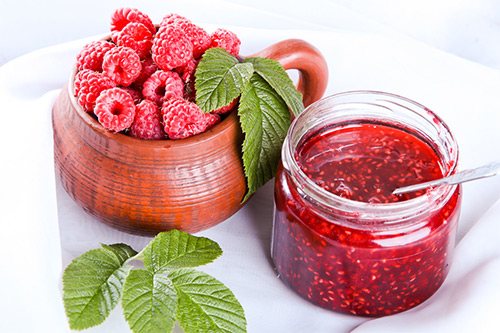
Raspberry jam is known as an indispensable remedy that really helps with colds. Vitamin C, as well as other vitamins and minerals, provide it with healing properties. Breast milk enriched with raspberries will acquire its healing properties.
But you should keep in mind: children’s bodies react individually to milk. For some babies, the berry is an allergen, so you should be careful about the baby’s reaction to the first raspberry supplement.
Apricot
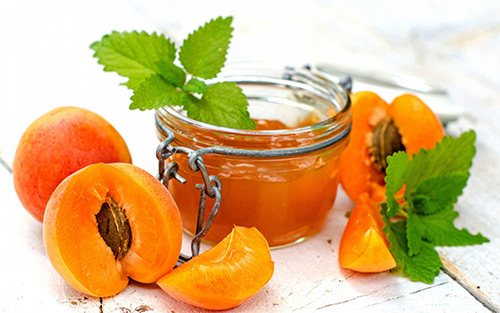
Apricot dessert is made from fruits that are rich in magnesium, potassium, and vitamins. They help normalize metabolism, as well as remove harmful components from the body. Apricots are known for their laxative effect, and the jam retains this property. Therefore, apricot jam is recommended for constipation, but it should not be eaten when a woman has an intestinal disorder.
Apple
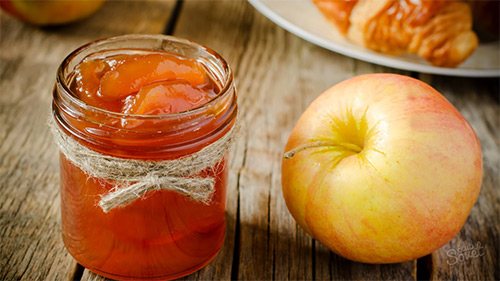
Apple jam is widespread not only because of the availability of apples. Its main advantage is associated with the beneficial properties of the fruit. A large amount of vitamins, pectin, fiber, iron and other minerals simply oblige a nursing mother to include apples in her diet. Fruit jam retains all the beneficial properties of the fruit, only slightly reducing their quantity.
Apple jam becomes especially valuable during lactation. It acquires such significance because it is hypoallergenic and practically harmless to infants. Experts give mothers only one piece of advice: it is better to choose yellow or green fruits for cooking; their hypoallergenicity is higher than that of red ones.
Strawberry
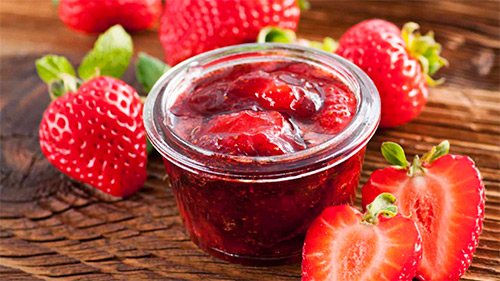
Strawberry jam is a product that is not only tasty, but also healthy. Thanks to vitamins B, C, pectins, carotene, folic and various organic acids, strawberry dishes normalize blood pressure, have a beneficial effect on nervous activity, and are good for the brain. The delicate berry has a strong effect on suppressing cancer cells; it is useful for weakened organisms.
Only one feature of strawberries can exclude this jam from a mother’s diet during breastfeeding: an individual allergic reaction. If neither the mother nor the baby has such a reaction, there are no prohibitions on its use during lactation.
Cherry
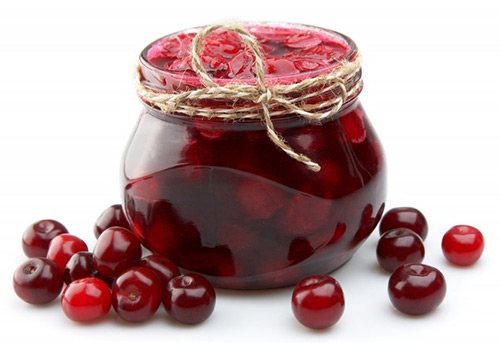
Cherry jam is rich in vitamins (groups B, E, P), and therefore is useful for almost everyone. And especially for women whose health is weakened due to anemia or atherosclerosis. For them, it will be both a delicacy and a sweet medicine, enriching the body with necessary microorganisms, minerals, and organic substances. It is better to cook cherry jam for a nursing mother without seeds.
However, the red color of the berries requires caution: if the baby is sensitive to such products, cherry jam is excluded!
From black currant
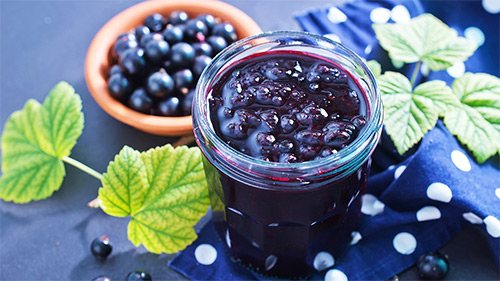
Blackcurrant jam is a dessert that is simply irreplaceable for many mothers during lactation! The properties of the berries make it so, they increase the volume of milk and improve its quality. After all, currants are distinguished by a high content of vitamin C. Therefore, the berry and dishes made from it strengthen the body, increase the mother’s and baby’s resistance to colds, and remove harmful substances. For colds, blackcurrant jam will replace medications for a nursing woman, relieve inflammation, and speed up the recovery process.
Plum
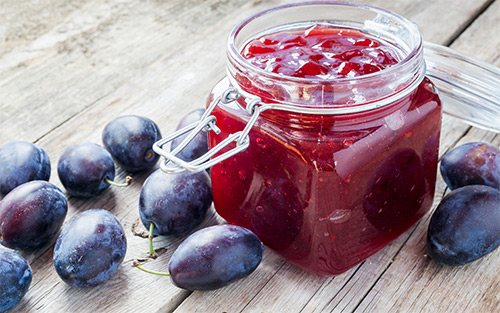
Plum jam has a thick consistency and delicate taste. A nursing mother, consuming plum jam, receives a whole range of essential substances: zinc, magnesium, calcium, etc. In addition, the pulp of the fruit contains vitamins B, E, K, PP, improves blood quality, and affects the elasticity of blood vessels.
The fruits have a laxative and diuretic effect. Therefore, women should not eat plum jam if they have gastrointestinal disorders. You also need to carefully monitor your baby’s reaction to milk and plum dessert.
From gooseberries
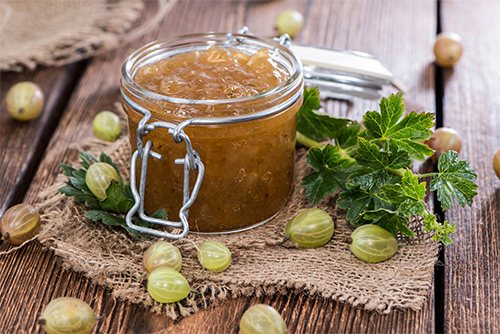
Gooseberry jam has a peculiar sweet taste with a sour tint. When cooked, gooseberries retain their healing properties. It is useful for the nervous and digestive systems, helps normalize metabolism. Boost immunity. Gooseberry jam retains the antibacterial and anti-inflammatory properties of the berries, which is important if mommy gets sick during breastfeeding.
When introducing this sweetness into the food of a nursing woman, some laxative effect of gooseberries should be taken into account. Therefore, if the mother or baby has loose stools, do not use this jam.
From quince
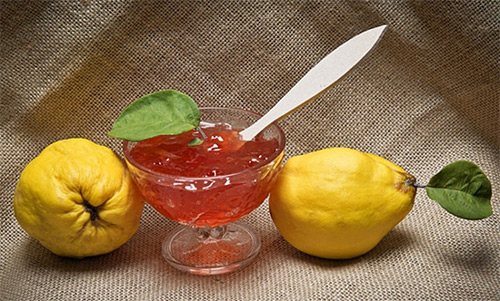
Quince jam or preserves are not as common as preparations from other fruits. However, those women who tried it during lactation were able to appreciate not only the taste, but also the effect of this fruit. Quince manages to replenish iron reserves in the body and improves the functioning of the gastrointestinal tract. What makes quince unique is its specific astringent taste and the same effect. Due to this, its use is recommended to stop bleeding and diarrhea.
But this same feature makes quince and dishes with it undesirable in case of increased blood clot formation in women. And the baby may experience bloating or constipation.
Strawberry
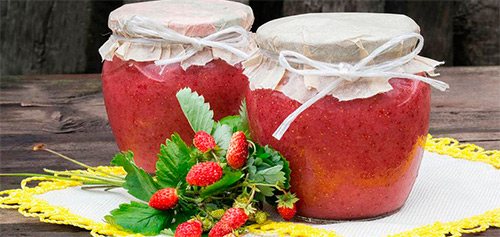
Strawberry jam is similar in properties and effects to strawberry jam. Strawberries are just as healing, contain vitamins necessary for the body and, like strawberries, require attention to the baby’s reaction.
Blueberry

Blueberry jam differs from others not only in its thick dark blue color. Wild berries have properties that other fruits do not have. They are recommended for women who have eye and cardiovascular diseases. Blueberries regulate the functioning of the pancreas and tidy up the gastrointestinal tract. Berries and dishes with them are allowed during breastfeeding. There is only one restriction on their use: the individual allergic reaction of the baby.
Dogwood

Dogwood jam attracts with its beautiful dark red color and pleasant sweet and sour taste. The value of jam is explained by the tonic and restorative properties of the fruit. Therefore, berries are useful for a nursing mother, especially with diarrhea and gas formation. But you need to be careful when eating dogwood jam. Due to its astringent properties, your baby may experience constipation.
Fourth month
When the baby grows up, the mother is allowed to supplement her diet with jam from fruits and berries of bright colors and flavors, such as citrus fruits.
Lemon
Lemon jam is unsafe for chronic ulcers, gastritis and pancreatitis.
In other cases, the treat will serve as a substitute for many medications, the use of which is contraindicated during breastfeeding.
Contains vitamins (A, B1, B2, B5, B6, B9, C, E); macro- and microelements (potassium, boron, iron, calcium, copper, sulfur, manganese, chlorine, sodium, fluorine, zinc, phosphorus, magnesium, molybdenum) and limonene with a powerful antifungal effect.
Properties:
- reduces temperature;
- strengthens the immune system;
- reduces sore throat;
- fights inflammatory processes;
- improves attention and performance;
- prevents heart disease;
- removes harmful substances from the body;
- lowers cholesterol levels;
- helps cope with swelling.
Storage. The shelf life of lemon jam is about 2 months in a cool, dry place. After this period, the beneficial properties are lost, and the taste is seriously deteriorated.
From six months
When the baby reaches the age of 6 months, a nursing woman is allowed to add other types of jam to her menu (provided it is natural).
Raspberry
Raspberry jam is included in the diet from three months, provided that the new mother is not allergic to this berry. But doctors still recommend waiting up to six months.
Caution should be exercised if you have diabetes. Contraindications: gastritis, asthma, increased acidity of gastric juice.
Contains vitamins A, B, including folic acid, C, E; mineral components (iron, manganese, iodine, magnesium, copper, zinc, chlorine, cobalt, phosphorus, potassium, boron, molybdenum); as well as organic acids (ellagic, salicylic, etc.).
Properties:
- improves immunity;
- has a diaphoretic effect;
- fights germs and inflammation;
- normalizes water and acid-base balance;
- removes toxins;
- blocks the growth of cancer cells;
- protects against anemia;
- supports normal liver and gonad functions.
It is considered the best substitute for medications during breastfeeding.
Carefully! There is a common misconception that raspberry jam can and should be used to reduce fever. But at high temperatures, a treat will only worsen your condition.
Rosehip
Rosehip jam is prohibited for: a predisposition to blood clots, gastritis, gastric hypersecretion, certain skin diseases (eczema, urticaria, dermatitis, etc.).
Contains vitamins (A, B1, B2, B9, C, E, K), mineral elements (calcium, potassium, phosphorus, magnesium, manganese, iron, copper, zinc); flavonoids and tannins (tannins), water-soluble fiber (pectin), malic and citric acids.
Properties:
- helps with exhaustion of the body after pregnancy and difficult childbirth;
- fights vitamin deficiency and anemia;
- useful for colds;
- stimulates carbohydrate metabolism;
- recommended for gastrointestinal diseases;
- treats inflammatory kidney diseases.
Important! Properly prepared rosehip jam does not contain lint or seeds (these inclusions are inedible and ultimately reduce the quality of the delicacy). The right time for use is the ARVI season.
Shop
Taking care of a child requires a lot of effort and time, so it’s easier to buy ready-made jam. But it can do more harm than good:
- Chemical preservatives, dyes and flavors in store-bought treats disrupt the functioning of internal organs, cause an allergic reaction, accumulation of excess fluid in the body and swelling, reduce the amount of breast milk and worsen a woman’s general well-being.
- The quality of raw materials (fruits and berries) used in the industrial production of sweets cannot be verified.
- The amount of sugar contained in the jam exceeds the norms recommended for breastfeeding.
- Storage conditions in warehouses are often violated.
If there is no alternative, choose the product carefully:
- The term “jam” implies that the product must have undergone heat treatment for at least 20 minutes and sterilization. An undercooked product causes fermentation in the stomach, is dangerous due to the rapid proliferation of harmful microorganisms and may contain traces of pesticides.
- You should not buy or eat expired jam, fermented or with traces of mold: there is a high risk of an eating disorder and more serious health consequences in the long term.
- The composition should only contain fruits/berries and sugar. At the same time, choose a single-component sweet, not an assortment.
- Glass containers with a tightly sealed lid are preferable. It is better to avoid plastic cups.
Homemade jam
The quality of the workpieces must be treated with extreme care. During lactation, mothers should not eat:
- preparations without heat treatment (berries pureed with sugar);
- five-minute jam;
- jam stored in improper conditions or not tightly sealed;
- a product prepared in violation of technology (this is indicated by mold under the lid, fermentation, etc.).
Even a small amount of spoiled jam can cause stomach upset in the mother, which affects the child’s well-being and disrupts the normal course of lactation.
Properly prepared jam can become sugary over time. There are two ways to bring it back to normal.
- The jam can be heated in a water bath by placing the jar in a pan of water and turning on the stove at low power.
- Alternatively, place some jam in a glass bowl or other suitable container and microwave for a few seconds.
Jam does not have to be eaten “in its pure form” - it can be used in baking, making fruit drinks and jelly. This will help a nursing woman satisfy her need for sweets and get a lot of vitamins and other beneficial substances contained in fruits and berries.

Homemade
Homemade jam is considered the best option for breastfeeding, since you control the entire process yourself.
It is better if the fruits and berries for cooking are collected from an area where chemicals and inorganic fertilizers are not used.
The most useful are considered to be fruits from open ground, not greenhouse ones. Since the former receive more natural light and contain maximum nutrients.
Life hack No. 1. To reduce the amount of surface pesticides, wash store-bought raw materials with the following solution: 1 tsp. sea salt and juice of half a lemon in a bowl of water.
The longer the path that fruits and berries take to the final point of sale, the more chemicals they contain, so give preference to those grown nearby.
Don't give in to temptation, don't buy early fruits out of season - they all contain nitrates.
Scientists have found that not all fruits and berries accumulate nitrates equally. The highest concentration is in melons and watermelons, and the lowest is in black currants, plums, cherries and apples.
Lifehack No. 2. To reduce nitrate content, soak fruits and vegetables in cold water for 15–20 minutes.
Do not store the gifts of nature before cooking (even in the refrigerator), cook immediately. Nitrates quickly turn into more dangerous substances - nitrites.
Life hack No. 3. To preserve as many useful substances as possible, you can first blanch the berries and fruits in boiling water, and then pour sugar syrup over them and keep them on the fire until fully cooked.
Homemade or store-bought jam?
Gone are the days when only homemade jam was available. However, many women still cook a sweet dish of fruits and berries at home. But manufacturers did not stand aside either. In the store you can find treats for every taste, even the most exotic fruits and berries. What is better for a nursing mother to choose? She should not base her choice only on taste preferences. The characteristics of each type are important.
Homemade
The advantage of homemade jam is accurate information about the ingredients included in it, as well as the absence of chemical additives.
The method of preparation is also important. Products that have not undergone heat treatment are not recommended for a nursing mother. Therefore, fresh berries that have been ground with sugar and stored in the refrigerator are not for a nursing woman. And five-minute jams too. She can only use those preserves, jams and marmalades that have been kept on the fire for at least 20 minutes. and more. This is the time during which heat treatment will destroy harmful microorganisms and bacteria.
Store-bought jam
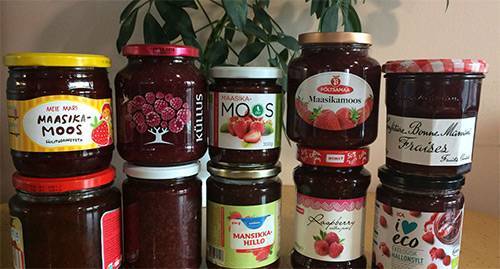
Store-bought jam is attractive because you can purchase a finished product that you can immediately add to your diet.
However, its purchase requires caution and attention
When buying jam for a nursing mother, you need to pay attention to the following aspects. Ingredients
We only take what is made from berries or fruits and sugar. Packages that contain information about other ingredients (thickeners, dyes, flavors) are pushed aside until the end of the GW
Ingredients. We only take what is made from berries or fruits and sugar. Packages that contain information about other ingredients (thickeners, dyes, flavors) are pushed aside until the end of the GW.
Compound. Only products cooked from one component, for example apples, are suitable. You should not take jars of multifruit jam, as this will make it more difficult to identify the component if allergic reactions occur.
Cooking method. We buy sterilized products to ensure protection from harmful microorganisms.
Package. During breastfeeding, you should not buy jam in plastic cups; choose only glass containers with a tight-fitting lid.
